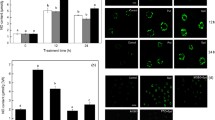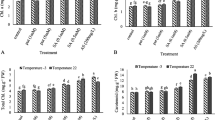Abstract
Seedlings of two tomato (Lycopersicon esculentum Mill.) cultivars, cv. Mawa (chilling-resistant) and cv. Moneymaker (chilling-sensitive) were used to investigate the effects of exogenous putrescine (Put) on chilling tolerance as well as on changes of physiological features and the fluctuation of free and conjugated endogenous polyamines (PAs) contents in the leaves under chilling stress. During chilling stress, accumulation of hydrogen peroxide (H2O2) was obviously detected in the leaves of both cultivars, but it was fewer in cv. Mawa. Meanwhile, d-arginine (d-Arg), a Put biosynthesis inhibitor caused more H2O2 accumulation in both cultivars, especially in cv. Moneymaker. By adding back Put to leaves, accumulation of H2O2 obviously reduced in two cultivars. Put was also involved in the increase of Fv/Fm and the decrease of malondialdehyde (MDA) in two cultivars under chilling stress. Despite the two cultivars displaying differential behavior towards enzymic antioxidants, enzymes and components of the ascorbate–glutathione (AsA–GSH) cycle in responses to chilling stress, d-Arg treatment diminished the enzyme activities and antioxidant contents induced by chilling stress and its reversion was performed by adding Put in both cultivars. During chilling stress, free and conjugated endogenous PA contents increased in two cultivars. d-Arg treatment inhibited the increases, and exogenously applied Put enhanced the increases in two cultivars. These results suggested that Put played important roles in the tolerance of tomato against chilling stress, which was most likely achieved by modulating antioxidant system as well as increasing free and conjugated PAs.








Similar content being viewed by others
Abbreviations
- AsA:
-
Ascorbic acid
- GSH:
-
Glutathione
- SOD:
-
Superoxide dismutase
- CAT:
-
Catalase
- POD:
-
Peroxidase
- APX:
-
Ascorbate peroxidase
- MDHAR:
-
Monodehydroascorbate reductase
- DHAR:
-
Dehydroascorbate reductase
- GR:
-
Glutathione reductase
- AsA–GSH:
-
Ascorbate–glutathione
- ROS:
-
Reactive oxygen species
- PAs:
-
Polyamines
- Put:
-
Putrescine
- Spd:
-
Spermidine
- Spm:
-
Spermine
- MDA:
-
Malondialdehyde
- D-Arg:
-
d-arginine
References
Apel K, Hirt H (2004) Reactive oxygen species: metabolism, oxidative stress, and signal transduction. Annu Rev Plant Biol 55:373–399
Asada K (1999) The water-water cycle in chloroplasts: scavenging of active oxygens and dissipation of excess photons. Annu Rev Plant Physiol Plant Mol Biol 50:601–639
Bian S, Jiang Y (2009) Reactive oxygen species, antioxidant enzyme activities and gene expression patterns in leaves and roots of Kentucky bluegrass in response to drought stress and recovery. Sci Hortic 120:264–270
Bradford MM (1976) A rapid and sensitive method for the quantification of microgram quantities of protein utilizing the principle of protein dye binding. Anal Biochem 72:248–254
Bray EA, Bailey-Serres J, Weretilnyk E (2000) Responses to abiotic stresses. In: Gruissem W, Buchannan B, Jones R (eds) Biochemistry and molecular biology of plants. American Society of Plant Physiologists, Rockville, pp 1158–1249
Broadbent P, Creissen GP, Kular B, Wellburn AR, Mullineaux P (1995) Oxidative stress responses in transgenic tobacco containing altered levels of glutathione reductase activity. Plant J 8:247–255
Cakmak I, Marschner H (1992) Magnesium deficiency and high light intensity enhance activities of superoxide dismutase, ascorbate peroxidase, and glutathione reductase in bean leaves. Plant Physiol 98:1222–1227
Chaparzadeh N, D’Amico ML, Khavari-Nejad RA, Izzo R, Izzo FN (2004) Antioxidative responses of Calendula offıcinalis under salinity conditions. Plant Physiol Biochem 42:695–701
Cuevas JC, Lopez-Cobollo R, Alcazar R, Zarza X, Koncz C, Altabella T, Salinas J, Tiburcio AF, Ferrando A (2008) Putrescine is involved in Arabidopsis freezing tolerance and cold acclimation by regulating ABA levels in response to low temperature. Plant Physiol 148:1094–1105
Dhindsa RS, Pulmb-Dhindsa P, Thorpe TA (1981) Leaf senescence: correlated with increased levels of membrane permeability and lipid peroxidation and decreased levels of superoxide dismutase and catalase. J Exp Bot 32:93–101
Drazkiewicz M, Skorzynska-Polit E, Krupa Z (2003) Response of the ascorbate-glutathione cycle to excess copper in Arabidopsis thaliana (L.). Plant Sci 164:195–202
Duan JJ, Li J, Guo S, Kang Y (2008) Exogenous spermidine affects polyamine metabolism in salinity-stressed Cucumis sativus roots and enhances short-term salinity. J Plant Physiol 165:1620–1635
Edreva AM, Velikova VB, Tsonov TD (2007) Phenylamides in plants. Russ J Plant Physiol 54:289–302
Falasca G, Franceschetti M, Bagni N, Altamura MM, Biasi R (2010) Polyamine biosynthesis and control of the development of functional pollen in kiwifruit. Plant Physiol Biochem 48:565–573
Foyer CH, Halliwell B (1976) The presence of glutathione and glutathione reductase in chloroplasts: a proposed role in ascorbic acid metabolism. Planta 133:21–25
Foyer CH, Noctor G (2011) Ascorbate and glutathione: the heart of the redox hub. Plant Physiol 155:2–18
Galston AW, Sawhney RK (1990) Polyamines in plant physiology. Plant Physiol 94:406–410
Galston AW, Kaur-Sawhney R, Altabella T, Tiburcio AF (1997) Plant polyamines in reproductive activity and response to abiotic stress. Bot Acta 110:197–207
Giannopolitis CN, Ries SK (1977) Superoxide dismutases: I. Occurrence in higher plants. Plant Physiol 59:309–314
Gill SS, Tuteja N (2010) Reactive oxygen species and antioxidant machinery in abiotic stress tolerance in crop plants. Plant Physiol Biochem 48:909–930
Gossett DR, Banks SW, Millhollon EP, Lucas MC (1996) Antioxidant response to NaCl stress in a control and a NaCl-tolerant cotton cell line grown in the presence of paraquat, buthionine sulfoximine and exogenous glutathione. Plant Physiol 112:803–809
Griffith OW (1980) Determination of glutathione and glutathione disulfide using glutathione reductase and 2-vinylpyridine. Anal Biochem 106:207–212
Groppa MD, Benavides MP (2008) Polyamines and abiotic stress: recent advance. Amino Acids 34:35–45
Gupta K, Dey A, Gupta B (2013) Plant polyamines in abiotic stress responses. Acta Physiol Plant 35:2015–2036
Hasanuzzaman M, Hossain MA, Fujita M (2011) Nitric oxide modulates antioxidant defense and the methylglyoxal detoxification system and reduces salinity-induced damage of wheat seedlings. Plant Biotecnol Rep 5:353–365
Hossain MA, Asada K (1984) Purification of dehydroascorbate reductase from spinach and its characterization as a thiol enzyme. Plant Cell Physiol 25:85–92
Hu X, Zhang Y, Shi Y, Zhang Z, Zou Z, Zhang H, Zhao J (2012) Effect of exogenous spermidine on polyamine content and metabolism in tomato exposed to salinity-alkalinity mixed stress. Plant Physiol Biochem 57:200–209
Jaleel CA, Riadh K, Gopi R, Manivannan P, Ine`s J, Al-Juburi HJ, Zhao CX, Shao HB, Panneerselvam R (2009) Antioxidant defense response: physiological plasticity in higher plants under abiotic constraints. Acta Physiol Plant 31:427–436
Janda T, Szalai G, Rios-Gonzales K, Veisa O, Paldi E (2003) Comparative study of frost tolerance and antioxidant activity in cereals. Plant Sci 164:301–306
Kim TE, Kim SK, Han TJ, Lee JS, Chang SC (2002) ABA and polyamines act independently in primary leaves of cold-stressed tomato (Lycopersicon esculentum). Physiol Plant 115:370–376
Kocsy G, Galiba G, Brunold C (2001) Role of glutathione in adaptation and signaling during chilling and cold acclimation in plants. Physiol Plant 113:158–164
Kusano T, Yamaguchi K, Berberich T, Takahashi Y (2007) Advances in polyamine research. J Plant Res 120:345–350
Law MY, Charles SA, Halliwell B (1983) Glutathione and ascorbic acid in spinach (Spinacia oleracea) chloroplasts. Biochem J 210:899–903
Liu Y, Zhao Z, Si J, Di C, Han J, An L (2009) Brassinosteroids alleviate chilling-induced oxidative damage by enhancing antioxidant defense system in suspension cultured cells of Chorispora bungeana. Plant Growth Regul 59:207–214
Mittler R (2002) Oxidative stress, antioxidants and stress tolerance. Trends Plant Sci 7:405–410
Mittova V, Theodoulou FL, Kiddle G, Gómez L, Volokita M, Tal M, Foyer CH, Guy M (2003) Coordinate induction of glutathione biosynthesis and glutathione-metabolizing enzymes is correlated with salt tolerance in tomato. FEBS Lett 554:417–421
Morita S, Kaminaka H, Masumura T, Tanaka K (1999) Induction of rice cytosolic ascorbate peroxidase mRNA by oxidative stress; involvement of hydrogen peroxide in oxidative stress signalling. Plant Cell Physiol 40:417–422
Nakano Y, Asada K (1981) Hydrogen peroxide is scavenged by ascorbate-specific peroxidase in spinach chloroplasts. Plant Cell Physiol 22:867–880
Nasibi F, Kalantari KM (2009) Influence of nitric oxide in protection of tomato seedling against oxidative stress induced by osmotic stress. Acta Physiol Plant 31:1037–1044
Noctor G, Foyer CH (1998) Ascorbate and glutathione: keeping active oxygen under control. Annu Rev Plant Physiol Plant Mol Biol 49:249–279
Ohe M, Kobayashi M, Niitsu M, Bagni N, Matsuzaki S (2005) Analysis of polyamine metabolism in soybean seedlings using 15N-labelled putrescine. Phytochemistry 66:523–528
Orozoco-Cardenas M, Ryan CA (1999) Hydrogen peroxide is generated systemically in plant leaves by wounding and systemin via the octadecanoid pathway. Proc Natl Acad Sci 96:6553–6557
Örvar BL, Ellis BE (1997) Transgenic tobacco plants expressing antisense RNA for cytosolic ascorbate peroxidase show increased susceptibility to ozone injury. Plant J 11:1297–1305
Prasad TK (1997) Role of catalase in inducing chilling tolerance in pre-emergent maize seedlings. Plant Physiol 114:1369–1376
Radhakrishnan R, Lee IJ (2013) Regulation of salicylic acid, jasmonic acid and fatty acids in cucumber (Cucumis sativus L.) by spermidine promotes plant growth against salt stress. Acta Physiol Plant 35:3315–3322
Rider JE, Hacker A, Mackintosh CA, Pegg AE, Woster PM, Casero RA Jr (2007) Spermine and spermidine mediate protection against oxidative damage caused by hydrogen peroxide. Amino Acids 33:231–240
Rizza F, Pagani D, Stanca AM, Cattivelli L (2001) Use of chlorophyll fluorescence to evaluate the cold acclimation and freezing tolerance of winter and spring oats. Plant Breed 120:389–396
Saruhan N, Saglam A, Kadioglu A (2012) Salicylic acid pretreatment induces drought tolerance and delays leaf rolling by inducing antioxidant systems in maize genotypes. Acta Physiol Plant 34:97–106
Saruyama H, Tanida M (1995) Effect of chilling on activated oxygen-scavenging enzymes in low temperature-sensitive and -tolerant cultivars of rice (Oryza sativa L.). Plant Sci 109:105–113
Shalata A, Mittova V, Volokita M, Guy M, Tal M (2001) Response of the cultivated tomato and its wild salt-tolerant relative Lycopersicon pennellii to salt-dependent oxidative stress: the root antioxidative system. Physiol Plant 112:487–494
Shen W, Nada K, Tachibana S (2000) Involvement of polyamines in the chilling tolerance of cucumber cultivars. Plant Physiol 124:431–439
Tambussi EA, Bartoli GG, Guiamet JJ, Beltrano J, Araus JL (2004) Oxidative stress and photo damage at low temperatures in soybean (Glycine max L. Merr.) leaves. Plant Sci 167:19–26
Tasgin E, Atici O, Nalbantoglu B, Popova LP (2006) Effects of salicylic acid and cold treatments on protein levels and on the activities of antioxidant enzymes in the apoplast of winter wheat leaves. Phytochemistry 67:710–715
Thomas RL, Jen JJ, Morr CV (1981) Changes in soluble and bound peroxidase, IAA oxidase during tomato fruit development. J Food Sci 47:158–161
Unal D, Tuney I, Sukatar A (2008) The role of external polyamines on photosynthetic responses, lipid peroxidation, protein and Chlorophyll content under the UV-A (352 nm) stress in Physcia semipinnata. J Photochem Photobiol B Biol 90:64–68
Velikova V, Yordanov I, Edreva A (2000) Oxidative stress and some antioxidant systems in acid rain-treated bean plants: protective role of exogenous polyamines. Plant Sci 151:59–66
Wi SJ, Kim WT, Park KY (2006) Overexpression of carnation S-adenosylmethionine decarboxylase gene generates a broad-spectrum tolerance to abiotic stresses in transgenic tobacco plants. Plant Cell Rep 25:1111–1121
Xu S, Hu J, Li Y, Ma W, Zheng Y, Zhu S (2011) Chilling tolerance in Nicotiana tabacum induced by seed priming with putrescine. Plant Growth Regul 63:279–290
Yang JC, Zhang JH, Liu K, Wang ZQ, Liu LJ (2007) Involvement of polyamines in the drought resistance of rice. J Exp Bot 58:1545–1555
Zhang W, Jiang B, Li W, Song H, Yu Y, Chen J (2009) Polyamines enhance chilling tolerance of cucumber (Cucumis sativus L.) through modulating antioxidative system. Sci Hortic 122:200–208
Acknowledgments
This study was financially supported by the 12th 5-Year Support Project of China (Grant No.: 2011BAD12B03), and the Major Scientific Research Projects of Liaoning Province (Grant No.: 2011215003).
Author information
Authors and Affiliations
Corresponding author
Additional information
Communicated by J. Kovacik.
Electronic supplementary material
Below is the link to the electronic supplementary material.
Rights and permissions
About this article
Cite this article
Song, Y., Diao, Q. & Qi, H. Putrescine enhances chilling tolerance of tomato (Lycopersicon esculentum Mill.) through modulating antioxidant systems. Acta Physiol Plant 36, 3013–3027 (2014). https://doi.org/10.1007/s11738-014-1672-z
Received:
Revised:
Accepted:
Published:
Issue Date:
DOI: https://doi.org/10.1007/s11738-014-1672-z




